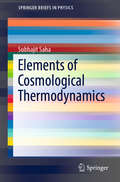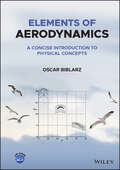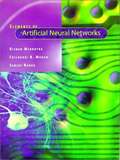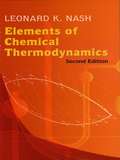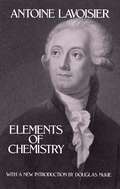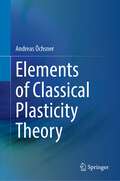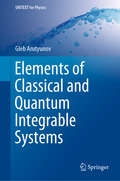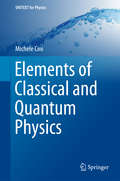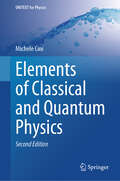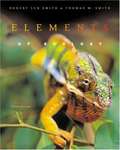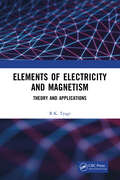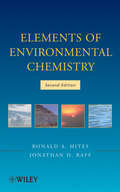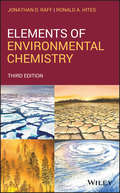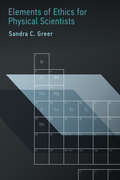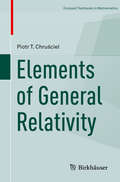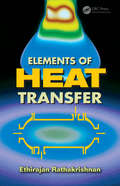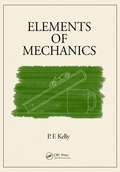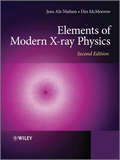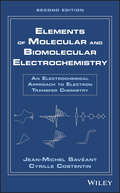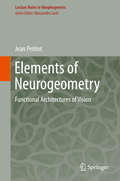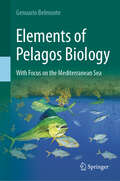- Table View
- List View
Elements of Cosmological Thermodynamics (SpringerBriefs in Physics)
by Subhajit SahaBased on the author’s own work and results obtained by renowned cosmologists, this short book provides a concise introduction to the relatively new research field of cosmological thermodynamics. Starting with a brief overview of basic cosmology and thermodynamics, the text gives an interesting account of the application of horizon thermodynamics to the homogeneous and isotropic Friedmann-Lemaitre-Robertson-Walker (FLRW) model, the inhomogeneous (Lemaitre-Tolman-Bondi) LTB model, and the gravitationally induced adiabatic particle creation scenario which is considered to be a viable alternative to the concordance Lambda-CDM model of the Universe. Both seasoned and new researchers in this field will appreciate the lucid presentation and the rich bibliography.
Elements of Aerodynamics: A Concise Introduction to Physical Concepts
by Oscar BiblarzELEMENTS OF AERODYNAMICS An accessible and hands-on textbook filled with chapter objectives, examples, practice problems, sample tests, and an online aero-calculator In Elements of Aerodynamics, Professor Oscar Biblarz delivers a concise and fundamentals-oriented approach to aerodynamics suitable for both undergraduate and graduate-level students. The text offers numerous problems, examples, and check tests, allowing readers to gain and cement their knowledge through hands-on practice. Using a unique blend of fundamentals, the book provides students with a new approach to high lift airfoils including examples designed to complement the theory. It covers the most vital information on incompressible and compressible flow over two-dimensional and three-dimensional wings. A companion website that includes an interactive aero-calculator and additional student resources makes this a suitable text for online, hybrid, and distance learning. Readers will also find: A concise introduction to units and notation with discussion of the proper usage of dimensionless coefficients in aerodynamics, featuring descriptions of airflow as an incompressible and compressible low-viscosity medium past streamlined wings Comprehensive re-evaluation of the fundamentals of fluid dynamics, including the differential control volume approach and formulation of lift, drag, and pitching moments for thin, attached boundary layers over slender wings at high angles of attack Practical applications of mass, momentum, and energy relations, derived from Euler’s equation, Bernoulli’s equation, and the Kutta-Joukowski theorem Selected treatment of transonic and hypersonic aerodynamic aspects, including supercritical airfoils, the non-linear small perturbation potential equation, Newtonian theory, and hypersonic lift and drag Well-suited for students enrolled in an introductory aerodynamics course as part of an engineering program, Elements of Aerodynamics will also earn a place in the libraries of physics students and those interested in basic fluid mechanics.
Elements of Artificial Neural Networks
by Kishan Mehrotra Chilukuri K. Mohan Sanjay RankaElements of Artificial Neural Networks provides a clearly organized general introduction, focusing on a broad range of algorithms, for students and others who want to use neural networks rather than simply study them. The authors, who have been developing and team teaching the material in a one-semester course over the past six years, describe most of the basic neural network models (with several detailed solved examples) and discuss the rationale and advantages of the models, as well as their limitations. The approach is practical and open-minded and requires very little mathematical or technical background. Written from a computer science and statistics point of view, the text stresses links to contiguous fields and can easily serve as a first course for students in economics and management. The opening chapter sets the stage, presenting the basic concepts in a clear and objective way and tackling important--yet rarely addressed--questions related to the use of neural networks in practical situations. Subsequent chapters on supervised learning (single layer and multilayer networks), unsupervised learning, and associative models are structured around classes of problems to which networks can be applied. Applications are discussed along with the algorithms. A separate chapter takes up optimization methods. The most frequently used algorithms, such as back propagation, are introduced early on, right after perceptrons, so that these can form the basis for initiating course projects. Algorithms published as late as 1995 are also included. All of the algorithms are presented using block-structured pseudo-code, and exercises are provided throughout. Software implementing many commonly used neural network algorithms is available at the book's website. Transparency masters, including abbreviated text and figures for the entire book, are available for instructors using the text.
Elements of Chemical Thermodynamics: Second Edition (Dover Books on Chemistry)
by Leonard K. NashThis text addresses the use of purely thermal data in calculating the position of equilibrium in a chemical reaction. Its argument highlights the physical content of thermodynamics, as distinct from purely mathematical aspects. Methods are limited to a very few of the most elementary operations of the calculus, all of which are explained in an appendix. Readers need no more than a sound background in high school mathematics and physics, as well as some familiarity with the leading quantitative concepts of an introductory college chemistry course.An introduction establishes the fundamentals of temperature, heat and work, reversibility, and pressure-volume work. The first principle of thermodynamics is explored in terms of energy, enthalpy, thermochemistry and Hess's Law, heat capacity, Kirchhoff's equations, and adiabatic processes. Considerations of the second principle of thermodynamics encompass the Carnot cycle, the concept of entropy, and evaluation of entropy changes. The consequences of thermodynamic principles are examined in chapters on the free energies, the Clapeyron equation, ideal solutions and colligative properties, and the equilibrium state and equilibrium constant. Numerous problems appear throughout the text, in addition to 30 fully worked illustrative examples.
Elements of Chemistry: In A New Systematic Order, Containing All The Modern Discoveries, Illustrated With Thirteen Copperplates
by Antoine LavoisierThe debt of modern chemistry to Antoine Lavoisier (1743–1794) is incalculable. With Lavoisier's discoveries of the compositions of air and water (he gave the world the term 'oxygen') and his analysis of the process of combustion, he was able to bury once and for all the then prevalent phlogiston doctrine. He also recognized chemical elements as the ultimate residues of chemical analysis and, with others, worked out the beginnings of the modern system of nomenclature. His premature death at the hands of a Revolutionary tribunal is undoubtedly one of the saddest losses in the history of science.Lavoisier's theories were promulgated widely by a work he published in 1789: Traité élémentairede Chimie. The famous English translation by Robert Kerr was issued a year later. Incorporating the notions of the "new chemistry," the book carefully describes the experiments and reasoning which led Lavoisier to his conclusions, conclusions which were generally accepted by the scientific community almost immediately. It is not too much to claim that Lavoisier's Traité did for chemistry what Newton's Principia did for physics, and that Lavoisier founded modern chemistry.Part One of the Traité covers the composition of the atmosphere and water, and related experiments, one of which (on vinous fermentation) permits Lavoisier to make the first explicit statement of the law of the conservation of matter in chemical change. The second part deals with the compounds of acids with various bases, giving extensive tables of compounds. Its most significant item, however, is the table of simple substances or elements — the first modern list of the chemical elements. The third section of the book reviews in minute detail the apparatus and instruments of chemistry and their uses. Some of these instruments, etc. are illustrated in the section of plates at the end.This new facsimile edition is enhanced by an introductory essay by Douglas McKie, University College London, one of the world's most eminent historians of science. Prof. McKie gives an excellent survey of historical developments in chemistry leading up to the Traité, Lavoisier's major contributions, his work in other fields, and offers a critical evaluation of the importance of this book and Lavoisier's role in the history of chemistry. This new essay helps to make this an authoritative, contemporary English-language edition of one of the supreme classics of science.
Elements of Classical Plasticity Theory
by Andreas ÖchsnerThis monograph provides a compact introduction into the classical, i.e. rate-independent, plasticity theory. Starting from the engineering stress-strain diagram, the concept of elastic and elasto-plastic material behavior is introduced, as well as the concept of uniaxial and multiaxial stress states. Continuum mechanical modeling in the elasto-plastic range requires, in regards to the constitutive equation, in addition to the elastic law (e.g. Hooke’s law), a yield condition, a flow rule and a hardening rule. These basic equations are thoroughly introduced and explained for one-dimensional stress states. Considering three-dimensional plasticity, different sets of stress invariants to characterize the stress matrix and the decomposition of the stress matrix in its hydrostatic and deviatoric part are introduced. Furthermore, the concept of the yield condition, flow rule and hardening rule is generalized for multiaxial stress states. Some typical yield conditions are introduced and their graphical representation in different stress spaces is discussed in detail. The book concludes with an introduction in the elasto-plastic finite element simulation of mechanical structures. In the context of numerical approximation methods, the so-called predictor-corrector methods are used to integrate the constitutive equations. This is again introduced in detail based on one-dimensional stress states and afterwards generalized to the three-dimensional case. Test your knowledge with questions and answers about the book in the Springer Nature Flashcards app.
Elements of Classical and Quantum Integrable Systems (UNITEXT for Physics)
by Gleb ArutyunovIntegrable models have a fascinating history with many important discoveries that dates back to the famous Kepler problem of planetary motion. Nowadays it is well recognised that integrable systems play a ubiquitous role in many research areas ranging from quantum field theory, string theory, solvable models of statistical mechanics, black hole physics, quantum chaos and the AdS/CFT correspondence, to pure mathematics, such as representation theory, harmonic analysis, random matrix theory and complex geometry. Starting with the Liouville theorem and finite-dimensional integrable models, this book covers the basic concepts of integrability including elements of the modern geometric approach based on Poisson reduction, classical and quantum factorised scattering and various incarnations of the Bethe Ansatz. Applications of integrability methods are illustrated in vast detail on the concrete examples of the Calogero-Moser-Sutherland and Ruijsenaars-Schneider models, the Heisenberg spin chain and the one-dimensional Bose gas interacting via a delta-function potential. This book has intermediate and advanced topics with details to make them clearly comprehensible.
Elements of Classical and Quantum Physics
by Michele CiniThis book presents the basic elements of theoretical physics in a highly accessible, captivating way for university students in the third year of a degree in physics. It covers analytical mechanics, thermodynamics and statistical physics, special and general relativity and non-relativistic quantum theory, fully developing the necessary mathematical methods beyond standard calculus. The central theme is scientific curiosity and the main focus is on the experimental meaning of all quantities and equations. Several recent verifications of General Relativity are presented, with emphasis on the physical effects – why they were predicted to exist and what signals they were seen to produce. Similarly, the basic reasons why superconductors have zero resistance and are perfect diamagnets are pinpointed. Quantum Eraser Experiments and Delayed Choice Experiments are described. Many statements of Quantum Theory are a challenge to common sense and some crucial predictions have often been considered hard to believe and have been tested experimentally. The book examines the EPR paradox, Bell states and teleportation.To show the beauty and richness of the subject, various topics from different areas of Physics are covered. These include: discrete quantum models and lattices (periodic and not), Casimir effect, Anyons, Fano Resonances, the Hanbury Brown and Twiss effect, the Aharonov-Bohm effect, the Meitner-Auger effect, Squeezed Light, the Rabi model, neutrino oscillations, aspects of Quantum Transport, Quantum Pumping, and Berry phases, black holes and cosmological problems.
Elements of Classical and Quantum Physics (UNITEXT for Physics)
by Michele CiniThis textbook presents an up to date perspective on the fundamental elements of theoretical physics. It encompasses analytical mechanics, thermodynamics and statistical physics, special and general relativity, and non-relativistic quantum theory, thoroughly developing the necessary mathematical methods beyond standard calculus while striving to be as clear, explicit, and direct as possible. The exposition of the theory, both in the classical and quantum parts, is expanded and reworked compared to the first edition. In parallel with the formalism, which is explained in full detail, several more experimental phenomena and techniques are included and discussed. Throughout, the emphasis is on the physical meaning of the theory, that is, the precise way in which the necessary experimental verification occurs or might occur in the future. With its comprehensive approach, rigorous mathematical treatments, and clear, physically oriented explanations of principles and experiments, this textbook is an essential resource for advanced undergraduate and graduate students of physics, as well as a valuable reference for researchers.
Elements of Cosmology
by Jayant V. NarlikarThe physical aspects of cosmology, including primordial nucleosynthesis, the astroparticle physics of inflation, and the current ideas on structure formation are discussed.
Elements of Crustal Geomechanics
by François Henri CornetThis key textbook considers the mechanics of geomaterials at a wide range of scales, both in time and space. It provides a detailed introduction to the study of crustal geomechanics, focusing specifically on the seismogenic crust. The author demonstrates how continuum mechanics principles can provide efficient solutions to geomechanics problems at various scales, taking into account the multiphase characteristics of the geomaterials as well as discontinuities such as fractures and faults. Field and laboratory observations are combined with basic mathematical theory to build solutions with known levels of uncertainty. Particular consideration is given to the use of microseismicity. Case studies are provided, and practical results from numerical modelling are used to illustrate the applicability and limitations of current theories. Accessible explanations of mathematical formulations, convenient summaries of the key equations, and exercises make this a valuable reference for students and researchers in geomechanics, geophysics, structural geology and engineering.
Elements of Ecology 5th Edition
by Robert Leo Smith Thomas M. SmithWith a modular organization and a beautiful four color art program, the fourth edition of this leading text for non-majors continues to provide a clear presentation of the principles of ecology and illustrate their relation to today's environmental issues. Far-reaching in its coverage, the fourth edition provides the most up-to-date information with a new chapter on global warming and deforestation. It also focuses on ecology as a science, providing the basic background information needed to show the relevance of studying environmental problems on a global scale.
Elements of Electricity and Magnetism: Theory and Applications
by R.K. TyagiThis book covers the theory, concepts, and applications associated with electricity and magnetism. It discusses various fundamental aspects including Coulomb’s Law, electric potential, capacitors, dielectrics, and paramagnetism. Aimed at undergraduate students with an elementary knowledge of mathematical analysis, it also includes solved problems at the end of each chapter for better understanding.The subject matter of this book also includes: The Biot-Savart Law RL Circuit Electromagnetic Wave Equation Displacement Current Equipotential Surfaces Print edition not for sale in South Asia (India, Sri Lanka, Nepal, Bangladesh, Pakistan or Bhutan)
Elements of Environmental Chemistry
by Ronald A. Hites Jonathan D. RaffFrom Reviews of the First Edition:"This splendid, at times humorous, and reasonably priced little book has much to commend it to undergraduate chemists and to other science students." -J. G. Farmer, University of Edinburgh"Complex environmental issues are presented in simple terms to help readers grasp the basics and solve relevant problems." -J. Albaiges, University of Barcelona "The main strength of the book lies in its explanations of the calculation of quantitative relationships. Each chapter includes 15-20 problems that are carefully chosen from a didactic standpoint, for which the reader can find solutions at the end." -D. Lenoir, Institute for Ecological Chemistry"What drew me to the first edition was the style - the no nonsense, down-to-earth explanations and the practical examples that litter the text. The dry humor expressed in the footnotes is great and reminds me of other classic texts." -T. Clough, Lincoln UniversityA practical approach to environmental chemistryProviding readers with the fundamentals of environmental chemistry and a toolbox for putting them into practice, Elements of Environmental Chemistry, Second Edition is a concise, accessible, and hands-on volume designed for students and professionals working in the chemical and environmental sciences.Tutorial in style, this book fully incorporates real-world problems and extensive end-of-chapter problem sets to immerse the reader in the field. Chapters cover mass balance, chemical kinetics, carbon dioxide equilibria, pesticide structures and much more. Extensively revised, updated, and expanded, this Second Edition includes new chapters on atmospheric chemistry, climate change, and polychlorinated biphenyls and dioxins, and brominated flame retardants. In addition, new practice problems and a helpful tutorial on organic chemistry names and structures have been added to improve both the scope and accessibility of the book.
Elements of Environmental Chemistry
by Ronald A. Hites Jonathan D. RaffA practical approach to environmental chemistry, Elements of Environmental Chemistry, 3rd Edition provides readers with the fundamentals of environmental chemistry and a toolbox for putting them into practice. This is a concise, accessible, and hands-on volume designed for students and professionals working in the chemical and environmental sciences. The 3rd Edition has been completely revised and rearranged. The first chapter on tool skills has been expanded to include thermodynamic considerations and measurement issues. The former chapter on the partitioning of organic compounds has been expanded to cover the fates of organic compounds, with an emphasis on developing the reader's "chemical intuition" for predicting a chemical's fate based on structure. The material on lead, mercury, pesticides, PCBs, dioxins, and flame retardants has been expanded and combined into the last chapter and supplemented with more references to the literature. The problem sets have been extended and now include over 130 problems, some of which can be solved using Excel.
Elements of Ethics for Physical Scientists
by Sandra C. GreerA guide to the everyday decisions about right and wrong faced by physical scientists and research engineers. This book offers the first comprehensive guide to ethics for physical scientists and engineers who conduct research. Written by a distinguished professor of chemistry and chemical engineering, the book focuses on the everyday decisions about right and wrong faced by scientists as they do research, interact with other people, and work within society. The goal is to nurture readers' ethical intelligence so that they know an ethical issue when they see one, and to give them a way to think about ethical problems. After introductions to the philosophy of ethics and the philosophy of science, the book discusses research integrity, with a unique emphasis on how scientists make mistakes and how they can avoid them. It goes on to cover personal interactions among scientists, including authorship, collaborators, predecessors, reviewers, grantees, mentors, and whistle-blowers. It considers underrepresented groups in science as an ethical issue that matters not only to those groups but also to the development of science, and it examines human participants and animal subjects. Finally, the book examines scientifically relevant social issues, including public policy, weapons research, conflicts of interest, and intellectual property. Each chapter ends with discussion questions and case studies to encourage debate and further exploration of topics. The book can be used in classes and seminars in research ethics and will be an essential reference for scientists in academia, government, and industry.
Elements of Friction Theory and Nanotribology
by Enrico Gnecco Ernst MeyerCombining the classical theories of contact mechanics and lubrication with the study of friction on the nanometer range, this multi-scale book for researchers and students alike guides the reader deftly through the mechanisms governing friction processes, based on state-of-the-art models and experimental results. The first book in the field to incorporate recent research on nanotribology with classical theories of contact mechanics, this unique text explores atomic scale scratches, non-contact friction and fishing of molecular nanowires as observed in the lab. Beginning with simple key concepts, the reader is guided through progressively more complex topics, such as contact of self-affine surfaces and nanomanipulation, in a consistent style, encompassing both macroscopic and atomistic descriptions of friction, and using unified notations to enable use by physicists and engineers across the scientific community.
Elements of General Relativity (Compact Textbooks in Mathematics)
by Piotr T. ChruścielThis book provides an introduction to the mathematics and physics of general relativity, its basic physical concepts, its observational implications, and the new insights obtained into the nature of space-time and the structure of the universe. It introduces some of the most striking aspects of Einstein's theory of gravitation: black holes, gravitational waves, stellar models, and cosmology. It contains a self-contained introduction to tensor calculus and Riemannian geometry, using in parallel the language of modern differential geometry and the coordinate notation, more familiar to physicists. The author has strived to achieve mathematical rigour, with all notions given careful mathematical meaning, while trying to maintain the formalism to the minimum fit-for-purpose. Familiarity with special relativity is assumed. The overall aim is to convey some of the main physical and geometrical properties of Einstein's theory of gravitation, providing a solid entry point to further studies of the mathematics and physics of Einstein equations.
Elements of Heat Transfer
by Ethirajan RathakrishnanWritten for chemical, mechanical, and aerospace engineering students taking courses on heat and mass transfer, this textbook presents the basics and proceeds to the required theory and its application aspects. Major topics covered include conduction, convection, radiation, boiling, heat exchangers, and mass transfer and are explained in a detailed,
Elements of Mathematical Methods for Physics
by Francis E. MensahElements of Mathematical Methods for Physics provides students with an approachable and innovative introduction to key concepts of mathematical physics, accompanied by clear and concise explanations, relevant real-world examples and problems that help them to master the fundamentals of mathematical physics. The topics are presented at a basic level, for students lacking a prior mathematical background.This book is designed to be covered in two semesters, presenting 18 chapters on topics varying from differential equations, matrix algebra and tensor analysis to Fourier transform, including special functions and dynamical systems.Upper-level undergraduate and graduate students of physics and engineering as well as professionals will gain a better grip of the basics and a deeper insight into and appreciation for mathematical methods for physics.Key Features:• Reviews and presents the basic math skills needed at the undergraduate level.• Chapters accompanied by examples and end-of-chapter problems to enhance understanding.• Introduces dynamical systems and includes a chapter on Hilbert Space
Elements of Mechanics
by P.F. KellyThe first volume in a three-part series, Elements of Mechanics provides a rigorous calculus-based introduction to classical physics. It considers diverse phenomena in a systematic manner and emphasises the development of consistent and coherent models guided by symmetry considerations and the application of general principles. Modern developments c
Elements of Modern X-ray Physics
by Des Mcmorrow Jens Als-NielsenEagerly awaited, this second edition of a best-selling text comprehensively describes from a modern perspective the basics of x-ray physics as well as the completely new opportunities offered by synchrotron radiation. Written by internationally acclaimed authors, the style of the book is to develop the basic physical principles without obscuring them with excessive mathematics.The second edition differs substantially from the first edition, with over 30% new material, including: A new chapter on non-crystalline diffraction - designed to appeal to the large community who study the structure of liquids, glasses, and most importantly polymers and bio-moleculesA new chapter on x-ray imaging - developed in close cooperation with many of the leading experts in the fieldTwo new chapters covering non-crystalline diffraction and imagingMany important changes to various sections in the book have been made with a view to improving the expositionFour-colour representation throughout the text to clarify key conceptsExtensive problems after each chapter There is also supplementary book material for this title available online (http://booksupport.wiley.com).Praise for the previous edition:"The publication of Jens Als-Nielsen and Des McMorrow's Elements of Modern X-ray Physics is a defining moment in the field of synchrotron radiation... a welcome addition to the bookshelves of synchrotron-radiation professionals and students alike.... The text is now my personal choice for teaching x-ray physics..." - Physics Today, 2002
Elements of Molecular and Biomolecular Electrochemistry: An Electrochemical Approach to Electron Transfer Chemistry (Baker Lecture Ser. #13)
by Jean-Michel Savéant Cyrille CostentinWritten by two of the world's leading authorities in the field of electrochemistry, this book comprehensively addresses workhorse electrochemical reactions that serve as the basis of modern research for alternative energy solutions. Provides an accessible and readable summary on the use of electrochemical techniques and the applications of electrochemical concepts to functional molecular-level systems Includes a new chapter on proton coupled electron transfer, a completely revamped chapter on molecular catalysis of electrochemical reactions, and added sections throughout the book Bridges a gap and strengthens the relationship between electrochemists, molecular and biomolecular chemists—showing a variety of functions that may be obtained by multi-component systems designed using the paradigms of both chemistries
Elements of Neurogeometry
by Jean PetitotThis book describes several mathematical models of the primary visual cortex, referring them to a vast ensemble of experimental data and putting forward an original geometrical model for its functional architecture, that is, the highly specific organization of its neural connections. The book spells out the geometrical algorithms implemented by this functional architecture, or put another way, the "neurogeometry" immanent in visual perception. Focusing on the neural origins of our spatial representations, it demonstrates three things: firstly, the way the visual neurons filter the optical signal is closely related to a wavelet analysis; secondly, the contact structure of the 1-jets of the curves in the plane (the retinal plane here) is implemented by the cortical functional architecture; and lastly, the visual algorithms for integrating contours from what may be rather incomplete sensory data can be modelled by the sub-Riemannian geometry associated with this contact structure. As such, it provides readers with the first systematic interpretation of a number of important neurophysiological observations in a well-defined mathematical framework. The book's neuromathematical exploration appeals to graduate students and researchers in integrative-functional-cognitive neuroscience with a good mathematical background, as well as those in applied mathematics with an interest in neurophysiology.
Elements of Pelagos Biology: With Focus on the Mediterranean Sea
by Genuario BelmonteOceans cover more than 70% of the Earth's surface, with an average depth of approximately 3,800 meters. Humanity is largely excluded from this vast world of saltwater, which remains mostly unexplored and unknown. The goal of this book is to introduce readers to this unfamiliar and mysterious realm. It delves into various species and communities in great detail, emphasizing that the taxonomy, life cycles, and ecological dynamics differ significantly from what is typically taught in basic Biology and Natural Sciences courses, which often focus on terrestrial or freshwater environments, and occasionally, benthic habitats. The pelagic lifestyle, by contrast, is rarely emphasized in Marine Biology textbooks. This book aims to shift that perspective, highlighting the pelagic way of life for marine organisms. As a teaching method, species, geographical locations, and key topics are repeatedly revisited throughout the text to enhance their visibility and reinforce their understanding in the minds of students.
